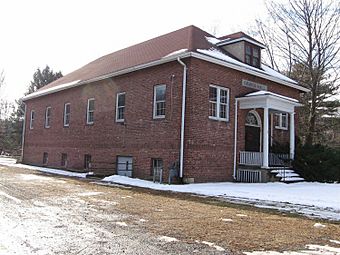Curtisville Historic District facts for kids
Quick facts for kids |
|
|
Curtisville Historic District
|
|

Grange Hall, Curtisville
|
|
| Location | Roughly, Pratt St. from Naubuc Ave. to W of Main St., also Parker Terr., Parker Terr. Extd. and adjacent parts of Naubuc, Glastonbury, Connecticut |
|---|---|
| Area | 90 acres (36 ha) |
| Architectural style | Colonial Revival, Mid 19th Century Revival, Late Victorian |
| NRHP reference No. | 92001638 |
| Added to NRHP | December 14, 1992 |
The Curtisville Historic District is a special area in northwestern Glastonbury, Connecticut. It's mostly a neighborhood with homes along Naubuc Avenue and Pratt Streets. This district shows how farming and factories once worked side-by-side in one small village. You can see old worker houses, former farm buildings, and even a small factory area. This historic district was added to the National Register of Historic Places in 1992 because of its important history.
Exploring Curtisville's Past
Curtisville is located in the northwest part of Glastonbury. It sits between Main Street on the east and the Connecticut River to the west. A small stream called Salmon Brook runs through the area. The district has two main parts, one north of the brook and one south.
What Kinds of Buildings Are Here?
Most of the buildings in Curtisville are houses. They were built from the late 1700s to the early 1900s. Many of these homes were built for workers in the local factories. They have a simple, traditional style, sometimes with touches of Federal and Greek Revival designs.
You can also find some larger houses that belonged to tobacco farmers. For example, there's a Foursquare-style house on Pratt Street from the early 1900s. Look closely and you might spot an Italianate villa, a fancy house built by a member of the Welles family who owned a mill. There's also a charming Gothic Revival cottage that was home to a factory supervisor. Near Parker Terrace, you'll see a small group of brick factory buildings, with the main ones built around 1870.
A Look at Curtisville's History
Curtisville was one of the first places in Glastonbury where English colonists settled. They started using the riverfront meadows for farming as early as the 1600s. People soon realized that Salmon Brook could power mills. However, factories didn't really start until the 1840s. That's when Oswin Welles began making wooden items and cigars.
Around the same time, two brothers, Frederick and Joseph Curtis, opened a big factory that made silver-plated items. Their business didn't have enough money and closed around 1860. Thomas Vail then took over the property. He made rifles and single-shot pistols during the American Civil War. After the war, his business also failed, and the factory went back to making silver-plated goods.
Farming tobacco remained very important in the area. There was also regular boat service at a dock at the end of Pratt Street. This helped transport goods and people along the river.



